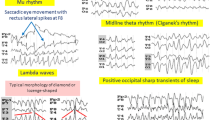Summary
Question of the study
BioSomnia is a portable one-channel EEG system that is able to describe sleep by neural network analysis and calculate the most important sleep parameters, similar to the QUISI device [3, 4, 7]. Moreover, it is able to create a hypnogram on the basis of EEG frequency analysis.
Methods
We compared sleep parameters from BioSomnia with sleep parameters from the visual analysis of polysomnographic registrations according to criteria by Rechtschaffen and Kales [6] to determine the predictive validity of the BioSomnia device.
Results
In 67 simultaneous sleep recordings, we found significant differences only for the following sleep parameters: sleep efficieney (SE), total sleep time (TST), episodes of wake (WE), and slow wave sleep (SWS). No significant differences were found for other sleep parameters.
Conclusions
BioSomnia is a new screening method that is able to differentiate between sleep and wakefulness and therefore represents a supporting tool for ambulatory sleep medicine. Of course, it will not be able to replace polysomnographic recordings in sleep laboratories. Sleep pathology in terms of light-to-moderate sleep fragmentation, but not severe sleep fragmentation, is sufficiently determined. The estimation of sleep quality in terms of amounts of SWS is limited and is not possible in the case of REM. Because of the lack of REM sleep detection, the cyclicity of sleep cannot be determined.
Zusammenfassung
Fragestellung
BioSomnia ist ein mobiles einkanäliges EEG-System, welches, ähnlich dem QUISI-System [3, 4, 7], in der Lage ist Schlaf mittels der Analyse neuronaler Netze zu beschreiben und die wichtigsten Schlafkennwerte zu berechnen. Basierend auf einer EEG-Frequenzanalyse kann es außerdem ein Hypnogramm erstellen.
Methodik
Um Voraussagen über die Validität des BioSomnia-Systems treffen zu können, haben wir die BioSomnia-Schlafparameter mit den Parametern einer visuellen Schlafstadienanalyse nach Rechtschaffen und Kales [6] verglichen.
Ergebnisse
In 67 simultanen Schlafableitungen haben wir nur in folgenden Parametem signifikante Abweichungen festgestellt: Schlafeffizienz (SE), Gesamtschlafzeit (TST), Wachepisoden (WE) und Tiefschlaf (SWS). Bei den anderen Schlafkennwerten konnten keine signifikanten Unterschiede festgestellt werden.
Schlussfolgerungen
BioSomnia ist ein neues Screening-Verfahren, welches Schlaf- und Wachzustand unterscheiden kann und stellt somit ein unterstützendes Instrument in der ambulanten Schlafmedizin dar. Allerdings wird es die polysomnographische Ableitung im Schlaflabor nicht ersetzen können. Die Pathologie des Schlafes in Form von Schlaffragmentierung wird in leichten und moderaten, aber nicht in schweren Fällen, ausreichend erfasst. Die Beurteilung der Schlafqualität in Form von Tiefschlafanteilen ist eingeschränkt und im Falle des REM-Schlafes nicht möglich. Aufgrund der fehlenden REM-Schlaf-Erkennung kann die Zyklik des Schlafes nicht bestimmt werden.
Similar content being viewed by others
References
Bland JM, Altman DG: Statistical methods for assesing agreement between two methods of clinical measurement. Lancet 1: 307–310, 1986.
Bortz J: Statistik für Sozialwissenschaftler. 5. Aufl., SpringerVerlag, Berlin, 1999.
Danker-Hopfe H: Vergleich der Schlafstadienklassifikation mittels QUISI und des visuellen Expertenscorings auf Basis einer PSG. Somnologie 4(Suppl 1): 30, 2000.
Ehlert I, Danker-Hopfe H, Höller L, von Rickenbach P, Baumgart-Schmitt R, Herrmann WM: A comparison between EEG-Recording and Scoring by QUISI Version 1.0 and Standard PSG with visual scoring. Somnologie 2: 104–116, 1998.
Obergottsberger S, Zeitlhofer J, Mayr N, Marschnigg E, Deeke L: Possibilities and limitations of the automatic analysis of sleep stages using the Oxford system. EEG-EMG 21(1): 29–34, 1990.
Rechtschaffen A, Kales A: A manual of standardized terminology, techniques and scoring system for sleep stages of human subjects. Brain Information Service/Brain Research Institute, University of California, Los Angeles, 1968.
Wiegand MH, Veselý Z, Galanakis P, Diplich S, Koussidis V: Schlafstadienbestimmung mit “QUIST”: Eine Validierungsstudie. Somnologie 4(Suppl 1): 30, 2000.
Author information
Authors and Affiliations
Corresponding author
Rights and permissions
About this article
Cite this article
Schweitzer, M., Mohammad, A., Binder, R. et al. BioSomnia—Validity of a mobile system to detect sleep and sleep quality. Somnologie 8, 131–138 (2004). https://doi.org/10.1111/j.1439-054X.2004.00030.x
Received:
Accepted:
Issue Date:
DOI: https://doi.org/10.1111/j.1439-054X.2004.00030.x




